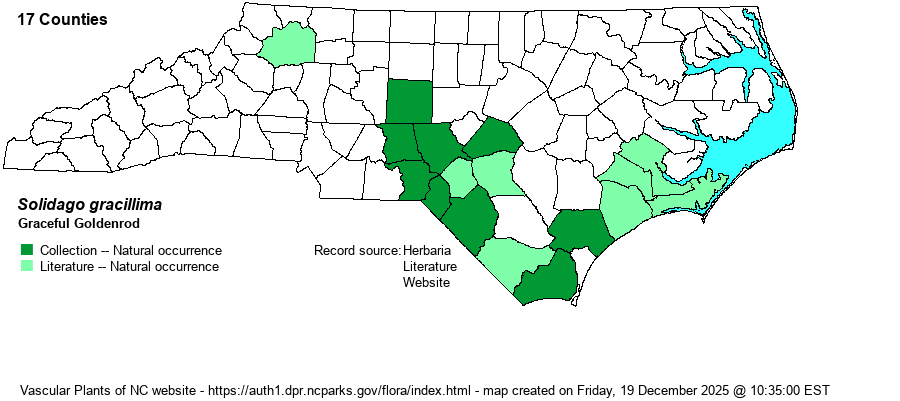| Section 6 » Order Asterales » Family Asteraceae |
Show/Hide Synonym
| taxonName | relationship | relatedTaxonName | relatedTaxonRefText | relComments |
|---|
| Solidago gracillima | < | Solidago gracillima | Gleason and Cronquist (1991) | | | Solidago gracillima | < | Solidago gracillima | Kartesz (1999) | | | Solidago gracillima | < | Solidago gracillima | Radford, Ahles, and Bell (1968) | | | Solidago gracillima | < | Solidago gracillima | Vascular Flora of the Southeastern States (Cronquist 1980, Isely 1990) | | | Solidago gracillima | < | Solidago gracillima | Flora of Virginia | | | Solidago gracillima | < | Solidago gracillima | Wofford (1989) | | | Solidago gracillima | < | Solidago gracillima | Wunderlin & Hansen Flora of Florida (3) | | | Solidago gracillima | > | Solidago perlonga | Fernald (1950) | | | Solidago gracillima | < | Solidago stricta ssp. gracillima | Flora of North America (1993b, 1997, 2000, 2002a, 2002b, 2003a, 2004b, 2005, 2006a, 2006b, 2006c, 2007a, 2009, 2010) | | | Solidago gracillima | > | Solidago gracillima | Small (1933, 1938) | | | Source: Weakley's Flora |
|
| Author | Torrey & A. Gray | |
| Distribution | There is no consensus yet among botanists that Graceful Goldenrod and Southern Goldenrod (S. austrina) are truly two distinct species or even varieties. This website follows Weakley (2020, 2024) for now and lists both entities as full species; however, in theory, the website editors feel that until the dust settles, it is best to lump the two, with the name S. gracillima having priority. Those who wish to distinguish the two can use the key in Weakley (2020, 2024). In NC, it occurs mainly in the Sandhills, lower Piedmont, and southeastern Coastal Plain. No records for the northern half of the Coastal Plain, despite it being listed for VA. However, the Digital Atlas of the Virginia Flora website does not include this species. The map below is just those counties where specimens reside at NCU, which hopefully has properly identified the species. Note that the range map of both this species and S. austrina are quite similar; however, Weakley's (2024) map does not include the NC Piedmont in the range, whereas it does for S. austrina.
Mostly Coastal Plain, VA to northern FL and southern AL. | |
| Abundance | The NCNHP currently has a State Rank of S3, and on the Watch List. However, the website editors recommend deleting it from the Watch List, as the species is under no particular threats at this time. It can be fairly common in the Sandhills, and uncommon to locally fairly common to the southeast toward the coast. Populations vary in number of plants from uncommon to common. A State Rank of S3S4, if not even S4, seems appropriate. | |
| Habitat | Moist to wet blackwater streamhead ecotones, Longleaf Pine-Wiregrass savannas and flatwoods, seepage areas in the eastern Piedmont. Across the full range of this species and the very similar S. austrina, Weakley (2024) states: ""Wet pine savannas, seepage bogs" for S. gracillima, but for S. austrina: "Piedmont prairie remnants, openings in xeric hardpan forests, upland depressions, clay roadbanks and powerline rights-of-way, post oak savannas, and open oak-hickory woodlands". Thus, he considers this species as occurring in Coastal Plain wetlands, but S. austrina is essentially found in uplands. | |
| Phenology | Flowering and fruiting August-October. | |
| Identification | This species is distinct in its slender stem with many small, erect, stalkless leaves and a terminal inflorescence. The latter varies from a simple, curved spike to a triangular-shape with short, curved branches. In NC it can be confused with Southern Wand Goldenrod (S. virgata), but that species is taller, has untoothed basal leaves (vs. many small teeth), and always has a simple spikelike inflorescence. It may also be confused with Carolina Goldenrod (S. pulchra), but that species is short(er) and has 8-13 ray florets per head (vs. just 1-8 rays). | |
| Taxonomic Comments | See comments under Distribution. There is agreement among botanists that gracillima/austrina is distinct from virgata (formerly stricta), having distinct morphology and habitats.
| |
| Other Common Name(s) | Virginia Goldenrod (an odd name, as it is not certain to occur there), Southern Bog Goldenrod | |
| State Rank | S3 [S3S4] | |
| Global Rank | G4? | |
| State Status | W1 | |
| US Status | | |
| USACE-agcp | OBL link |
| USACE-emp | OBL link |

